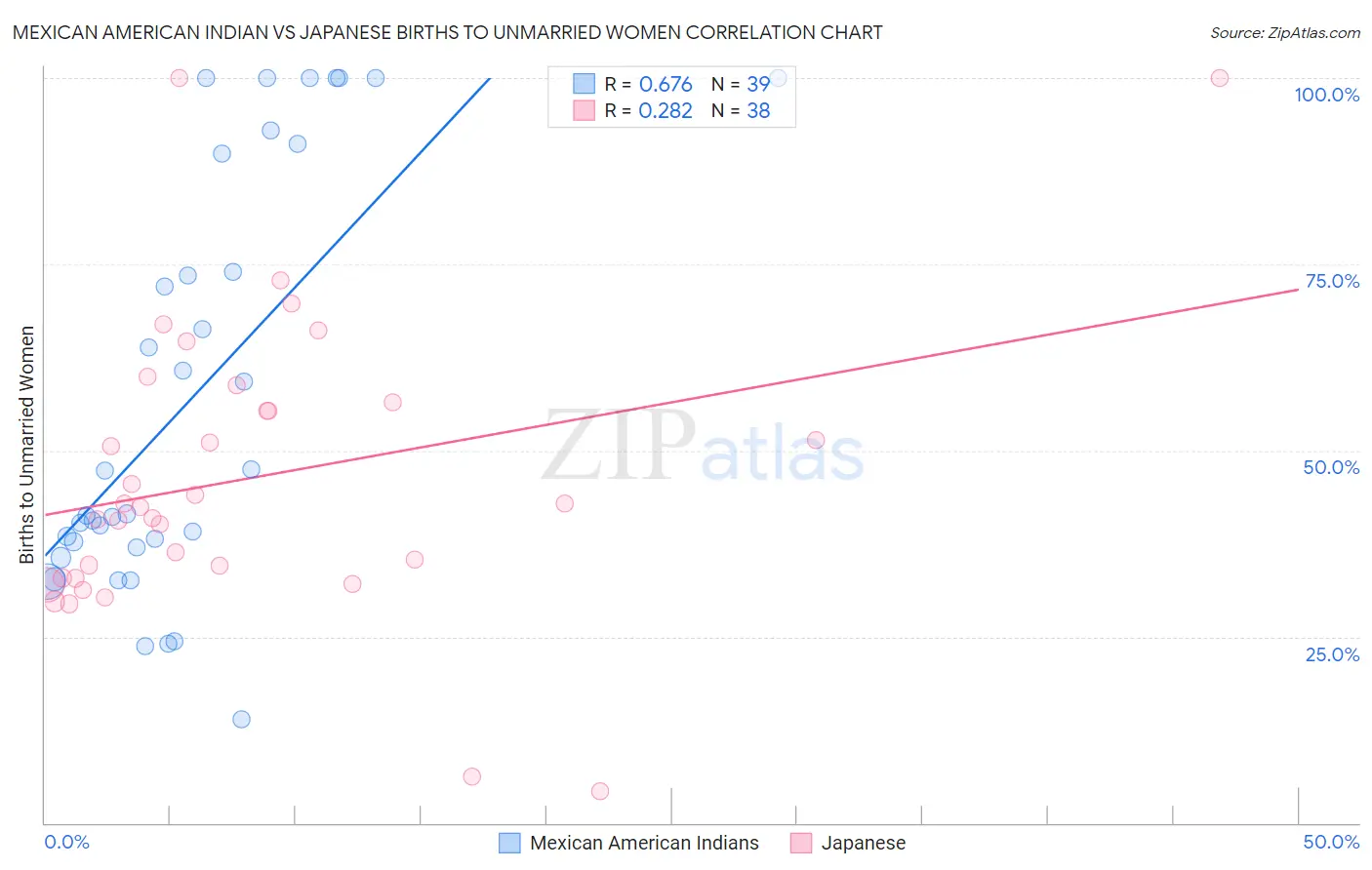Mexican American Indian vs Japanese Births to Unmarried Women
COMPARE
Mexican American Indian
Japanese
Births to Unmarried Women
Births to Unmarried Women Comparison
Mexican American Indians
Japanese
35.7%
BIRTHS TO UNMARRIED WOMEN
0.4/ 100
METRIC RATING
250th/ 347
METRIC RANK
35.2%
BIRTHS TO UNMARRIED WOMEN
0.9/ 100
METRIC RATING
243rd/ 347
METRIC RANK
Mexican American Indian vs Japanese Births to Unmarried Women Correlation Chart
The statistical analysis conducted on geographies consisting of 305,475,949 people shows a significant positive correlation between the proportion of Mexican American Indians and percentage of births to unmarried women in the United States with a correlation coefficient (R) of 0.676 and weighted average of 35.7%. Similarly, the statistical analysis conducted on geographies consisting of 240,312,984 people shows a weak positive correlation between the proportion of Japanese and percentage of births to unmarried women in the United States with a correlation coefficient (R) of 0.282 and weighted average of 35.2%, a difference of 1.7%.

Births to Unmarried Women Correlation Summary
| Measurement | Mexican American Indian | Japanese |
| Minimum | 13.9% | 4.3% |
| Maximum | 100.0% | 100.0% |
| Range | 86.1% | 95.7% |
| Mean | 57.1% | 46.3% |
| Median | 41.5% | 42.6% |
| Interquartile 25% (IQ1) | 36.9% | 32.9% |
| Interquartile 75% (IQ3) | 89.8% | 56.4% |
| Interquartile Range (IQR) | 52.9% | 23.5% |
| Standard Deviation (Sample) | 27.6% | 19.9% |
| Standard Deviation (Population) | 27.2% | 19.7% |
Demographics Similar to Mexican American Indians and Japanese by Births to Unmarried Women
In terms of births to unmarried women, the demographic groups most similar to Mexican American Indians are Immigrants from Western Africa (36.0%, a difference of 0.57%), Bermudan (35.5%, a difference of 0.61%), Nonimmigrants (35.5%, a difference of 0.62%), Salvadoran (36.0%, a difference of 0.69%), and Immigrants from Nigeria (35.4%, a difference of 0.96%). Similarly, the demographic groups most similar to Japanese are Guyanese (35.2%, a difference of 0.060%), Shoshone (35.3%, a difference of 0.40%), Indonesian (35.0%, a difference of 0.49%), Nigerian (35.3%, a difference of 0.51%), and Immigrants from Guyana (35.0%, a difference of 0.59%).
| Demographics | Rating | Rank | Births to Unmarried Women |
| Immigrants | Cameroon | 1.6 /100 | #236 | Tragic 34.7% |
| Marshallese | 1.6 /100 | #237 | Tragic 34.8% |
| Immigrants | Cambodia | 1.6 /100 | #238 | Tragic 34.8% |
| Sierra Leoneans | 1.4 /100 | #239 | Tragic 34.9% |
| Immigrants | Middle Africa | 1.2 /100 | #240 | Tragic 34.9% |
| Immigrants | Guyana | 1.2 /100 | #241 | Tragic 35.0% |
| Indonesians | 1.2 /100 | #242 | Tragic 35.0% |
| Japanese | 0.9 /100 | #243 | Tragic 35.2% |
| Guyanese | 0.9 /100 | #244 | Tragic 35.2% |
| Shoshone | 0.8 /100 | #245 | Tragic 35.3% |
| Nigerians | 0.7 /100 | #246 | Tragic 35.3% |
| Immigrants | Nigeria | 0.7 /100 | #247 | Tragic 35.4% |
| Immigrants | Nonimmigrants | 0.6 /100 | #248 | Tragic 35.5% |
| Bermudans | 0.6 /100 | #249 | Tragic 35.5% |
| Mexican American Indians | 0.4 /100 | #250 | Tragic 35.7% |
| Immigrants | Western Africa | 0.3 /100 | #251 | Tragic 36.0% |
| Salvadorans | 0.3 /100 | #252 | Tragic 36.0% |
| Immigrants | Portugal | 0.2 /100 | #253 | Tragic 36.2% |
| Potawatomi | 0.2 /100 | #254 | Tragic 36.2% |
| Chickasaw | 0.2 /100 | #255 | Tragic 36.3% |
| Immigrants | Trinidad and Tobago | 0.2 /100 | #256 | Tragic 36.3% |